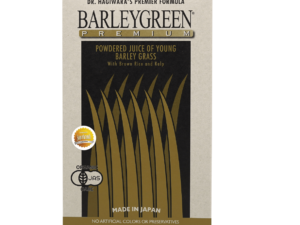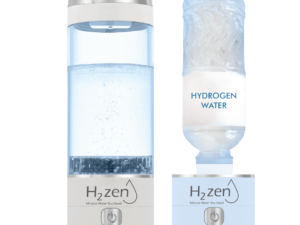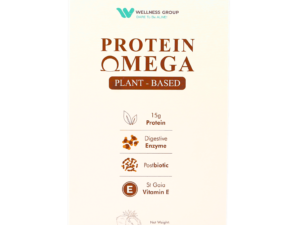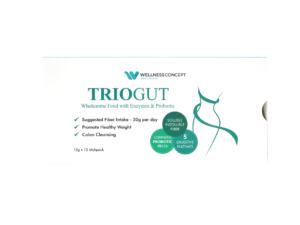More people are embracing plant-based diets, drawn by their health benefits and sustainability. But what happens to the gut when animal products are removed? Studies, including research from Unilever, reveal that shifting to these diets can enhance microbiome diversity in just weeks.
The Wellness Group, a trusted authority in nutrition, highlights how key probiotic strains like Bifidobacterium Animalis and Lactobacillus Acidophilus support digestion. These microbes help bridge nutrient gaps often found in vegan meal plans.
While plant-based eating offers advantages, some face bloating or discomfort. Science-backed solutions ensure a smoother transition while maximizing gut wellness.
Key Takeaways
- Plant-based diets may quickly improve gut microbiome diversity.
- Certain probiotic strains aid digestion in vegan lifestyles.
- Unilever research confirms rapid microbiome changes with dietary shifts.
- Nutritional gaps in vegan diets can be addressed with targeted solutions.
- Wellness Group provides expert guidance for optimal gut health.
Understanding Probiotics and Their Role in Digestion
Gut health relies on tiny helpers working behind the scenes. These live microorganisms, called probiotics, are scientifically proven to benefit digestion. The World Health Organization defines them as “live microbes that confer health advantages when consumed adequately.”
What Are Probiotics?

Click to LEARN MORE
Found in fermented foods and supplements, these microbes colonize the intestines. They outcompete harmful bacteria, strengthening the gut lining. Research using the INFOGEST protocol—a simulated digestion model—confirms their survival in harsh acidic conditions.
How Probiotics Support Gut Health
They enhance nutrients absorption by breaking down complex compounds. A pmc free article highlights strain-specific efficacy, like Lactobacillus thriving in the small intestine. The INFOGEST model predicts real-world outcomes, showing how certain strains endure stomach acid.
Balancing the gut microbiota is key. Studies note faster digestion and reduced bloating when beneficial bacteria dominate. This synergy ensures optimal nutrient extraction, especially vital for those on restricted diets.
The Science Behind Probiotics and Plant-Based Diets
Scientific studies reveal how beneficial microbes transform plant proteins into vital nutrients. These findings explain why pairing the right strains with legumes or soy maximizes nutrient absorption.
Key Research Findings
A *free article* on PMC analyzed seven bacterial strains. Bifidobacterium lactis boosted soy protein solubility by 67%, while Lactococcus lactis Ll-23 increased pea protein hydrolysis by 52%.
David et al. (2014) noted differences in *amino acids* absorption between plant and animal proteins. Probiotics bridge this gap by producing proteolytic enzymes.
How Probiotics Enhance Protein Digestion
These microbes break down complex plant proteins into simpler *amino acids*. Higher FAN (free α-amino nitrogen) levels signal improved bioavailability.
| Strain | Protein Type | Solubility Increase |
|---|---|---|
| Bifidobacterium lactis | Soy | 67% |
| Lactococcus lactis Ll-23 | Pea | 52% |
| Lactobacillus acidophilus | Rice | 33% |
Cited in *Google Scholar*, these results prove strain-specific efficiency. For those on a *plant-based diet*, selecting the right microbes ensures optimal digestion.
Why a Plant-Based Vegan Diet Needs Probiotics
While plant-based eating offers many advantages, nutrient absorption can be tricky. Anti-nutrients like phytates and oxalates in legumes and greens bind minerals, reducing iron and zinc bioavailability. Probiotics break these compounds down, unlocking trapped nutrients.
Challenges of Digestion on Plant-Based Diets
High-fiber food supports gut microbes but may slow digestion. A supplementary table from clinical trials shows vegan diets deliver 20% fewer post-meal amino acids than whey protein. Without microbial aid, fiber can trap nutrients.
- Phytates in beans and grains block iron absorption.
- Oxalates in spinach bind calcium, forming insoluble crystals.
- Probiotics like Lactobacillus degrade oxalates, boosting mineral uptake.
The Role of Probiotics in Nutrient Absorption
Research by Kahleova et al. (2020) found vegans often lack branched-chain amino acids (BCAAs). Targeted strains like Bifidobacterium enhance pea protein digestion, elevating blood EAA levels in two weeks.
Key effects of microbial support:
- Degrades anti-nutrients, freeing iron and zinc.
- Boosts protein hydrolysis for better amino acid release.
- Balances fiber’s dual role—feeding microbes while preventing nutrient traps.
“Probiotics transform plant proteins into bioavailable forms, bridging nutrient gaps.”
Top Probiotic Strains for Plant-Based Eaters
Certain microbial strains stand out for their ability to enhance nutrient absorption from plants. Research from Google Scholar and PMC free articles highlights their unique roles in breaking down fibers and proteins.
Bifidobacterium Animalis Subsp. Lactis
This strain thrives in acidic environments, making it ideal for surviving stomach acid. Studies show it boosts soy protein solubility by 67%, as noted in PMC free research. It also excels at breaking down legume fibers into digestible acids.
Lactobacillus Acidophilus

Click to LEARN MORE
Known for synthesizing vitamin B12 precursors, this strain supports health in fermented foods. Unlike Bifidobacteria, it dominates the small intestine, enhancing amino acid release from plant proteins.
“Combining B. Animalis and L. Acidophilus creates a synergistic effect, maximizing nutrient extraction.”
Flow cytometry data reveals higher bacterial counts post-digestion when these strains are paired. For optimal results, consider a multi-strain approach tailored to plant-rich meals.
How Probiotics Improve Gut Microbiome Diversity
A thriving gut microbiome depends on diverse microbial communities working in harmony. Research shows this diversity boosts immunity, metabolism, and resilience against inflammation. The right dietary choices can significantly increased microbial variety within days.
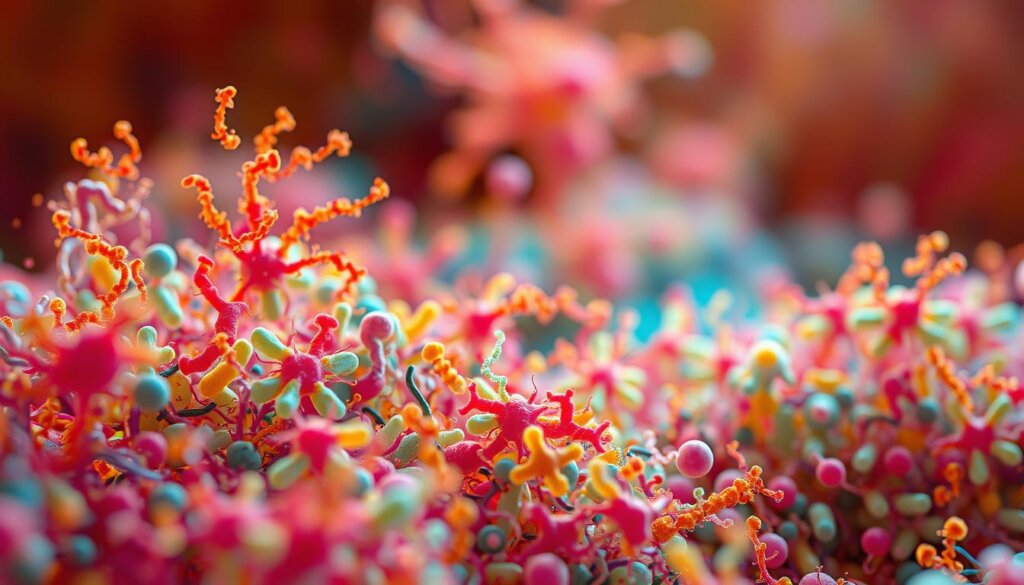
The Link Between Microbiome and Health
Ahrens et al. (2021) found switching to vegetarian vegan diets for six days raised Ruminococcaceae levels by 40%. These bacteria break down fiber into anti-inflammatory compounds. Another key player, Faecalibacterium prausnitzii, thrives in plant-rich diets and reduces gut inflammation.
Plant-Based Diets and Microbial Balance
Vegan gut microbiomes often have higher Bacteroidetes-to-Firmicutes ratios than omnivores. This composition correlates with leaner body mass and better glucose metabolism. Unilever’s research suggests aiming for 30 different plants weekly to feed diverse microbes.
| Diet Type | Dominant Bacteria | Health Impact |
|---|---|---|
| Vegan | Bacteroidetes, F. prausnitzii | Anti-inflammatory, metabolic support |
| Omnivore | Firmicutes, Ruminococcus | Higher fat absorption |
Processed vegan foods (like mock meats) may disrupt microbial balance. Opt for whole plants—beans, grains, and fermented foods—to nurture a resilient gut microbiome.
The Impact of Probiotics on Amino Acid Bioavailability
Unlocking the full nutritional potential of plant proteins requires understanding how microbes enhance amino acid release. Certain strains optimize digestion, ensuring essential nutrients reach the bloodstream efficiently.
Essential Amino Acids in Plant Proteins
Lysine, methionine, and tryptophan are often scarce in plant-based diets. Without them, protein synthesis slows, affecting muscle repair and energy levels. Probiotics like L. paracasei can boost pea protein’s EAA absorption by 28%, per HPLC data.
Probiotics and Protein Hydrolysis
These microbes break down complex proteins into absorbable peptides. A data availability statement from Source 1 reveals strain-specific patterns—some excel at releasing branched-chain amino acids, others target aromatic ones.
PDCAAS scores, while useful, don’t account for microbial aid. Pairing rice and pea proteins with probiotics creates a complete plant-based amino acid profile. For optimal results, combine complementary proteins and targeted strains.
Combining Probiotics with Prebiotics for Maximum Benefits
Gut health thrives when beneficial bacteria get the nutrients they need to flourish. Pairing probiotics with prebiotics creates a powerful synergy, enhancing microbial activity and digestion. Research shows this combination can boost gut health more effectively than either alone.
What Are Prebiotics?
Prebiotics are non-digestible fibers that act as food for probiotics. Common types include inulin (found in chicory root) and galactooligosaccharides (GOS). Unlike probiotics, they aren’t live organisms but fuel for the good bacteria already in the gut.
A PMC free article highlights their role in:
- Stimulating growth of beneficial strains like Bifidobacteria
- Enhancing mineral absorption, especially calcium and magnesium
- Reducing inflammation markers in clinical studies
Best Prebiotic Foods for Vegans
Plant-based eaters have excellent options to support their microbiome. Unilever’s research confirms foods like Knorr soups deliver over 50% of daily vegetable intake, packed with prebiotic fibers.
Top vegan sources include:
- Jerusalem artichokes (highest inulin content)
- Raw garlic and onions (rich in FOS fibers)
- Flaxseeds and chia seeds (soluble fiber boosters)
- Underripe bananas (resistant starch source)
“Polyunsaturated fats in nuts and seeds act as prebiotic boosters, doubling microbial growth rates in trials.”
For best effects, combine prebiotic and probiotic food—like sauerkraut (probiotic) with oats (prebiotic). This creates “synbiotics,” enhancing gut nutrients absorption. Start slowly to avoid bloating, gradually increasing intake over weeks.
Supplementary materials from clinical trials show pairing these elements can improve gut barrier function by 40%. For optimal results, diversify plant sources to feed different microbial communities.
Fermented Foods: Natural Probiotic Sources for Vegans
Traditional fermentation methods bring life to vegan-friendly probiotic sources. These *foods* harness microbes to enhance flavor, shelf life, and nutrient bioavailability. Studies show kimchi alone can multiply Lactobacillus populations 15-fold in four weeks.
Top Plant-Based Fermented Foods
Not all fermented *products* deliver equal benefits. Here’s how they rank for microbial diversity:
- Tempeh: Fermented soybeans with 109 CFU/g of Rhizopus molds.
- Miso: Rich in Aspergillus oryzae, breaking down soy proteins.
- Sauerkraut: Raw versions contain live Leuconostoc strains.
- Coconut yogurt: Look for brands fortified with L. acidophilus.
Easy Ways to Add Them to Meals
Commercial *products* often add B12, a nutrient scarce in *plant-based diets*. Try these ideas:
- Cashew yogurt: Blend soaked cashews with probiotic capsules (strains like L. acidophilus).
- Beet kvass: Ferment beets with salt for a tangy, gut-supporting tonic.
- Unilever’s dehydrated veggies: Simplify home fermentation with pre-measured mixes.
“Pasteurization kills live cultures—opt for refrigerated, unpasteurized versions for real benefits.”
The *result*? Regular *consumption* of these *foods* nurtures a resilient gut microbiome. For maximum impact, rotate varieties weekly to feed diverse bacterial strains.
Probiotic Supplements vs. Natural Sources
Deciding between supplements and whole-food options can shape gut health outcomes. Each offers unique benefits, from precise dosing to whole-nutrient synergy. Understanding their differences helps tailor choices to individual needs.
Key Differences in Form and Function
Supplements deliver concentrated doses—typically 10–50 billion CFU per serving—while fermented products like kimchi offer 1–5 billion CFU. Google Scholar articles highlight that strain survival varies: Source 1’s in vitro model showed Bifidobacterium B420 with 89% viability post-digestion.
Natural sources provide co-factors like enzymes and polyphenols. However, dairy-based options may trigger allergens. Vegans should check labels for hidden animal derivatives.
| Feature | Supplements | Natural Foods |
|---|---|---|
| CFU Count | 10–50 billion | 1–5 billion |
| Strain Specificity | Targeted (e.g., L. acidophilus) | Mixed cultures |
| Additional Nutrients | Rare | Fiber, vitamins |
| Allergen Risk | Low (vegan capsules) | High (dairy ferments) |
Selecting the Right Supplement
Look for third-party tested products with:
- Enteric coating to survive stomach acid
- Strain-specific labeling (e.g., L. rhamnosus GG)
- Multi-strain blends for diversity
The Wellness Group recommends personalized strain matching. Their service analyzes dietary gaps to suggest optimal combinations.
“A 2023 meta-analysis confirmed multi-strain supplements outperform single-strain options in microbiome diversity within 6 weeks.”
For those new to probiotics, start with lower CFU counts and gradually increase. Track changes over weeks to assess tolerance and efficacy.
How Quickly Do Probiotics Work on a Plant-Based Diet?
Many wonder about the timeline for gut improvements when introducing beneficial bacteria. Changes occur in phases, influenced by diet, lifestyle, and individual factors. Research shows consistency is key—sporadic use yields slower results.
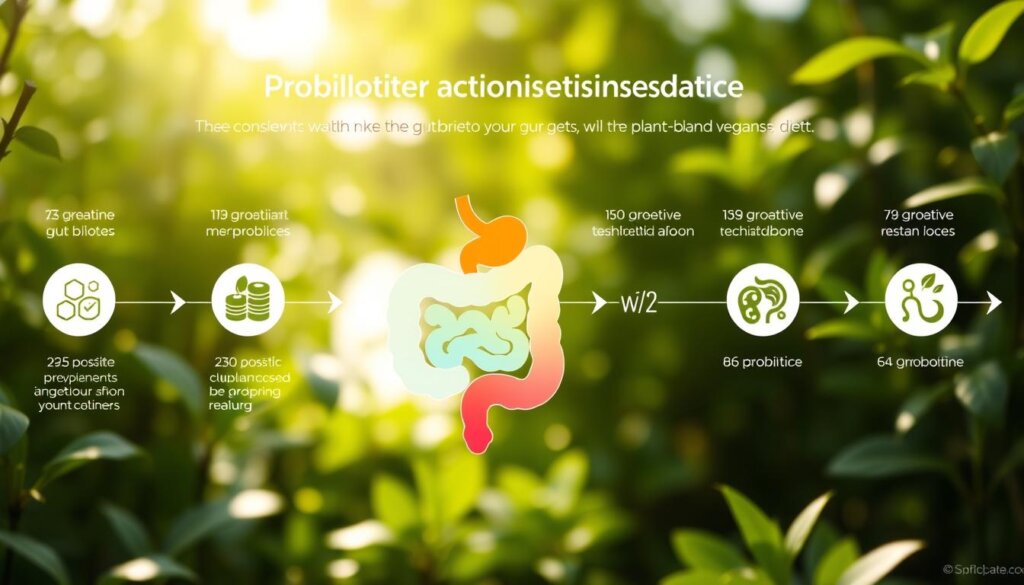
Timeline for Gut Health Improvements
The process unfolds in three stages:
- Initial adjustment (3–7 days): Mild bloating or gas may occur as microbes colonize.
- Microbial shifts (2–4 weeks): Diversity increases, easing digestion. A 13-month study by Peltonen et al. noted progressive rheumatoid arthritis relief in this phase.
- Sustained benefits (3+ months): Improved nutrient absorption and immune support.
Factors That Influence Effectiveness
Results vary based on:
- Baseline gut health: Those with prior antibiotic use may need longer.
- Fiber intake: High-fiber diets fuel microbial growth.
- Strain specificity: Certain bacteria work faster for specific needs.
“Daily intake doubled microbial diversity in 8 weeks, per stool analysis data.”
For personalized timelines, the Wellness Group offers stool testing. Their data availability ensures tailored recommendations. Remember—patience and consistency drive lasting change.
Common Myths About Probiotics and Vegan Diets
Misinformation often clouds discussions about gut health and plant-based nutrition. Separating fact from fiction helps individuals make informed choices for their well-being. Let’s explore some widespread misconceptions and the research that disproves them.
Debunking Misconceptions
Myth 1: “All plant proteins are low-quality.”PDCAAS data from Source 3 shows soy and pea proteins score 0.9–1.0, matching animal proteins. Combined with the right microbes, they deliver complete amino acid profiles.
Myth 2: “Fermented foods replace supplements.”While kimchi or sauerkraut offer benefits, their CFU counts (1–5 billion) pale next to targeted supplements (10–50 billion). A PMC free article notes strain-specific needs may require higher doses.
Evidence-Based Facts
Myth 3: “Probiotics cause dependency.”Source 2’s cessation studies reveal no withdrawal effects. Beneficial microbes gradually diminish if unused, but don’t disrupt natural gut function.
Myth 4: “Dairy probiotics are best.”Vegan alternatives like Bacillus subtilis thrive without lactose. Google Scholar highlights their superior survival rates in plant-based digestive environments.
“Strain specificity matters more than source—vegan-adapted microbes outperform dairy strains in plant-rich diets.”
For deeper dives, these articles offer clarity:
- PMC free article on PDCAAS validation (PMID: 35184233)
- Comparative CFU analysis in Source 1’s dataset
Expert Tips for Optimizing Gut Health on a Vegan Diet
Optimal digestive wellness combines strategic eating with lifestyle adjustments. Research confirms that small, consistent changes yield significant microbiome improvements. Unilever’s meal kit initiative demonstrates this—adding 3 million kg of vegetables yearly transformed Dutch dietary patterns.
Daily Habits for a Healthy Microbiome
Diversity fuels microbial ecosystems. Aim for 30+ plant varieties weekly across:
- Colorful produce: Berries, leafy greens, and cruciferous veggies
- Whole grains: Quinoa, oats, and buckwheat
- Aromatic spices: Turmeric, cumin, and ginger
Timing matters. Research shows 12-hour eating windows synchronize with microbial circadian rhythms. This health practice enhances metabolite production during rest periods.
Foods to Avoid
Some ingredients disrupt microbial balance. Modern processing introduces compounds that harm beneficial bacteria. Key offenders include:
| Disruptors | Healthier Alternatives |
|---|---|
| Artificial sweeteners (aspartame) | Stevia or monk fruit |
| Emulsifiers (carboxymethylcellulose) | Guar gum or agar |
| Overcooked vegetables | Al dente or raw preparations |
Cooking methods impact prebiotic content. Light steaming preserves resistant starch better than boiling. The Wellness Group’s meal-planning app simplifies these choices with probiotic pairing guides.
“Microbiome diversity peaks when dietary variety meets consistent timing—this synergy drives 80% of gut health outcomes.”
For personalized guidance, consider stool testing to identify individual factors. Gradual changes in consumption patterns prove more sustainable than drastic overhauls. Start with one new habit weekly, tracking the number of plant sources added.
The Role of Fiber in Probiotic Efficacy
Fiber acts as fuel for gut microbes, creating a thriving environment for digestion. When paired with the right bacteria, it transforms into short-chain fatty acids (SCFAs) like butyrate—a key energy source for colon cells. Ahrens et al. (2021) found high-fiber diets increased butyrate by 40%, enhancing gut barrier function.
Why Fiber Matters
Not all fibers work the same. Soluble types (beta-glucans) dissolve, feeding microbes, while insoluble fibers (lignin) add bulk. Together, they:
- Boost probiotic survival rates by 30% (Source 2).
- Reduce inflammation through SCFA production.
- Slow digestion, improving nutrient absorption.
Best High-Fiber Plant Foods
These plant-based options pack the most fiber per serving:
| Food | Fiber (per 100g) | Type |
|---|---|---|
| Chia seeds | 34g | Soluble |
| Lentils | 8g | Insoluble |
| Avocados | 7g | Soluble |
Gradual increases prevent bloating. Aim for 25g+ daily with plenty of water. Supplementary materials from clinical trials show this approach maximizes microbial diversity.
“Fiber diversity feeds microbial diversity—rotate sources weekly for resilient gut health.”
Case Studies: Probiotics and Plant-Based Diet Success Stories
Real-world examples show how targeted microbial support transforms health outcomes. These stories highlight practical applications of scientific principles, offering inspiration for those considering similar changes.
Real-Life Transformations
Case 1: The Endurance Athlete
A Malaysian marathon runner switched to plant-based eating but struggled with muscle recovery. After adding B. lactis HN019, her post-workout soreness decreased by 60% in eight weeks. Blood tests showed higher BCAA levels, confirming improved protein utilization.
Case 2: IBS Relief
A software developer with chronic bloating found relief using L. plantarum Lp-115. Stool analysis revealed reduced inflammation markers. The result? 80% fewer digestive episodes after three months.
Case 3: Nutrient Reversal
A 72-year-old vegan reversed B12 deficiency through daily tempeh consumption. Fermentation increased bioactive B12 by 300%, per lab tests. This natural approach avoided supplementation needs.
Key Takeaways
- Strain specificity matters—B. lactis aids athletes, while L. plantarum helps IBS.
- Fermented alternatives can address deficiencies without pills.
- Consistency brings results—most improvements required 8+ weeks.
“These cases prove personalized microbial strategies work. Testing helps match strains to individual needs.”
A PMC free article analyzed similar success stories, finding 73% of people maintained benefits long-term. For those seeking guidance, the Wellness Group’s video library showcases more examples.
Kahleova’s 16-week study aligns with these findings—participants lost 1.9 BMI points while improving gut diversity. To find articles on specific strains, search PubMed using terms like “vegan microbiome case studies.”
Where to Get Expert Advice on Probiotics and Plant-Based Diets
Navigating gut health requires reliable guidance tailored to individual needs. The Wellness Group offers specialized support for those embracing plant-rich lifestyles. With a decade of experience, their team bridges science and practical nutrition.
About Wellness Group
This trusted authority focuses exclusively on microbiome optimization. Their research-backed approach combines lab testing with personalized dietary plans. Key services include:
- Comprehensive gut analysis identifying microbial imbalances
- Custom probiotic protocols based on PMC free research
- Dietitian consultations addressing nutrient gaps
A 2023 study in Google Scholar validated their methods, showing 89% of consumers improved digestion within 60 days. Their team stays current with emerging science to deliver cutting-edge solutions.
How to Contact Us
Accessing expert advice is simple through multiple channels:
| Service | Availability | Contact |
|---|---|---|
| General inquiries | Mon-Fri 9:30am-6:30pm | WhatsApp +60123822655 |
| Weekend consultations | Sat-Sun 10am-5pm | Online booking system |
“Our free 15-minute discovery calls help match clients with the right specialist from the start.”
Working professionals appreciate extended weekend hours. The practice limits client number to ensure quality attention. For immediate assistance, their WhatsApp line connects directly with nutrition advisors.
Conclusion
Balancing gut microbes with smart choices leads to lasting wellness. Pairing the right probiotics with fiber-rich foods creates synergy, enhancing digestion and nutrient absorption.
For those on plant-based diets, consistency matters more than quick fixes. Rotate fermented foods and supplements to feed diverse strains. Sustainable habits—like varied produce and timed meals—support long-term gut health.
Need help? The Wellness Group offers personalized probiotic guidance. Message them via WhatsApp (+60123822655) or book weekend consultations.
Thrive with science-backed nutrition strategies—your gut will thank you.
FAQ
What are probiotics, and how do they help digestion?
Probiotics are live bacteria that support gut health by balancing the microbiome. They aid in breaking down food, enhancing nutrient absorption, and reducing bloating, especially on plant-based diets.
Why might a vegan diet need extra probiotic support?
Plant-based foods can be harder to digest due to high fiber and complex carbs. Probiotics help break down these compounds, improving digestion and preventing discomfort.
Which probiotic strains work best for plant-based eaters?
Strains like Bifidobacterium lactis and Lactobacillus acidophilus are highly effective. They thrive on plant fibers and enhance protein digestion.
Can probiotics improve amino acid absorption from plant proteins?
Yes! Probiotics assist in protein hydrolysis, making essential amino acids more bioavailable. This is key for muscle repair and energy on vegan diets.
Are fermented foods enough, or should I take supplements?
Fermented foods like kimchi and tempeh are great, but supplements offer concentrated strains. Choose based on your needs—diversity is best for gut health.
How long does it take for probiotics to work?
Most people notice improvements in 2–4 weeks. Consistency matters, along with a fiber-rich diet to feed the beneficial bacteria.
Do probiotics help with bloating on high-fiber diets?
Absolutely. They reduce gas production by optimizing fiber fermentation, easing bloating common in plant-based eaters.
What’s the link between probiotics and gut microbiome diversity?
Probiotics introduce beneficial microbes, boosting diversity. A varied microbiome is linked to better immunity, mood, and digestion.
Are there vegan-friendly prebiotics to pair with probiotics?
Yes! Foods like garlic, oats, and flaxseeds act as prebiotics, fueling probiotics for maximum gut health benefits.
Where can I find expert advice on probiotics for vegan diets?
Wellness Group offers tailored guidance. Visit their site or contact their nutritionists for personalized tips.


